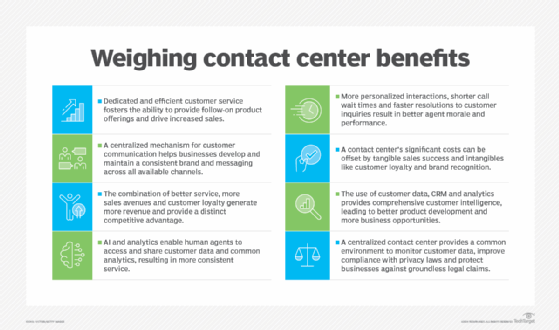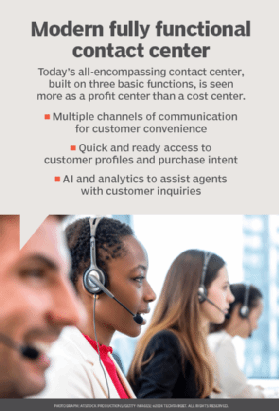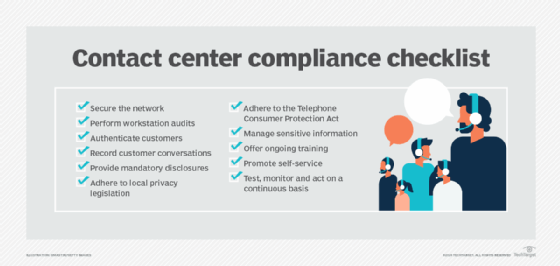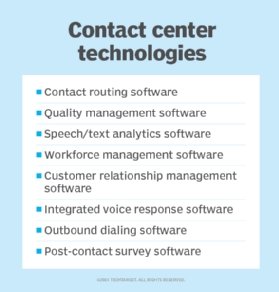10 best practices for contact center quality assurance
To ensure quality and results in the contact center, businesses must define clear metrics, use real-time analytics, seek customer feedback, upskill agents and automate everywhere.
Companies invest tremendous resources into finding ways to improve the contact center experience for customers and agents. Customer service requests come from every direction: mobile apps, web chatbots, social media, text messaging apps and emails. If issues remain unresolved, the communications escalate to agent-assisted calls and live chats.
How can contact center managers monitor this flood of interactions to ensure consistency across channels and high-quality customer service?
Contact center quality assurance evaluates calls and digital interactions using predefined criteria that align with the organization's quality standards and broader business goals. QA analysts use monitoring forms and quality scorecards to rate agent performance, including first call/contact resolution (FCR) rate, average handling time (AHT) and service level. Investment in digital and AI transformations has enabled many companies to move the quality assurance process beyond spreadsheets and random samplings of customer interactions.
"Quality assurance as a function is being transformed by AI," said Eric Buesing, partner at McKinsey & Company. In a traditional process, he explained, a human-based team pulls a sampling of random calls at some threshold, for example, 100 calls a week. They listen to customer interactions to monitor compliance and other quality standards. "But the best organizations are listening to 100% of calls using AI and then flagging exceptions, which are then listened to by a human-centric team," Buesing said. "So, it is moving from human-centric to AI-centric."
Better customer service can increase customer retention, build brand loyalty, and in some instances, produce higher sales revenue and profitability. Consistency and high-quality customer service are accomplished by rating individual agent performance using predefined criteria and offering coaching and constructive feedback.

Quality assurance can help companies uncover positive and negative customer and service trends, streamline communications processes and improve workflow and operational efficiency. The following strategies can enhance contact center QA for customer service interactions and promote continuous improvement of training processes and agent performance.
1. Define clear metrics and consistently track them
Contact center managers can enlist the expertise of QA analysts and trainers to document the internal and external standards required for high-quality customer interactions. The exact metrics will depend on the company and industry, but they generally assess queues, calls/contacts and service levels. FCR, AHT, average speed of answer (hold time before connecting with an agent), and call abandonment rate (customer hangups) are KPIs for the contact center QA process.
Contact center agents receive a QA score for each customer interaction based on weighted scoring in categories such as greeting and introduction, product knowledge, problem-solving skills, script compliance and adherence to company policies and procedures. It's important to compile evaluation results, analyze recurring performance issues and identify trends by considering questions such as these: Are agents hitting these KPIs and metrics? What happens if workloads end up being heavier because of attrition or unexpected call volumes? How will these scenarios be evaluated?
2. Use a large enough sample size
While some estimates put the average sample size per agent at two calls per week, industry organizations such as the Quality Assurance and Training Connection (QATC) claim that rating agent performance on one to two calls per week is "not statistically valid" unless that information is primarily used to support coaching sessions.

According to compiled statistics from QATC quarterly surveys of its members, representing large and small businesses with contact centers ranging from less than 50 to 500 agents, more than half of respondents said they evaluated one to five calls per agent, per month and about one-third monitored six to 10 calls per agent, per month. In addition, a single QA analyst could be responsible for 50 to 100 agents.
3. Continuously improve automation efforts
Many contact centers automate all or parts of routine customer service interactions using website chatbots, AI-based voice assistants and integrated voice response systems so human agents can assist customers with more complex service requests and transactions. Conversational AI, which uses natural language processing (NLP) to understand speech and text, has reduced contact center reliance on live agents for some customer interactions in voice and digital channels. Gartner projects 10% of agent interactions will use automation by 2026, compared to just 1.6% in 2022.
"Now that we've got this ability to further mature chatbots using generative AI, it has some interesting consequences, but also some interesting opportunities," said Christopher Sladdin, director analyst for Gartner's customer service and support practice.
4. Conduct regular QA testing and maintenance
It's important to continuously QA test the functionality and performance of chatbots and interactive voice systems to ensure these self-service channels operate as planned from the development stage to deployment cycles.
"Customers have more options than ever before," Buesing said, "and that creates a lot of complexity for an organization because what we hear from customers is, 'I want a consistent experience.' The challenge that a lot of organizations face is that a lot of those functions are siloed, meaning that the digital component of a service function might actually not be controlled by customer operations at all. It might be [controlled] by IT, and they have different priorities."
5. Use real-time monitoring and analytics
QA teams can monitor real-time interactions between agents and customers, using call monitoring software, dashboards and speech-to-text analytics tools. Interactive analytics uses NLP, AI and machine learning to process and analyze intelligent conversations in recorded calls and transcripts of digitized transactions.
Some of these tools can provide sentiment analysis to determine whether the customer is happy or angry based on keywords and characteristics like voice pitch. But it's important to balance AI-driven recommendations with human judgement for overall fairness, especially in areas like intent and empathy, which is hard for machine learning to quantify. Speech analytics tools enable QA analysts to track customer interactions and agent performance metrics such as script compliance and hold times.

6. Seek customer feedback
Contact center KPIs focus on customer loyalty and achieving a 75% or higher customer satisfaction (CSAT) score and 20% or higher net promoter score (NPS). CSAT measures how satisfied a customer is with the company's products and services, and NPS is based on a single survey question that rates a customer's likelihood to recommend the company and its products and services to others. Data is collected from surveys, interviews and related methods.
CSAT isn't a direct correlation with agent performance because the customer may focus on the result rather than the quality of the customer service, but it's necessary to include customer feedback tools in the quality assurance process. These tools can help QA teams develop objectives and methods to collect customer feedback such as surveys, emails, interviews and social media. Customer data can be used to identify gaps and learn more about the quality issues customers face.
"Most customers don't set their expectations for service based on a competitor or a peer," Buesing advised. "They set it based on the best experience that they are receiving from any brand or service."
7. Install a QA team leader
Companies that have added oversight of the QA process to the tasks of a contact center supervisor or trainer should consider designating a full-time QA manager. The QA team leader is responsible for overseeing the quality assurance process and managing the QA team, including developing and implementing the key processes that the QA team follows for monitoring and evaluating interactions. This role often entails training the QA analysts and agents if the company doesn't have a designated QA trainer. Importantly, the QA leader works with the QA data analyst to understand customer feedback and other data and reports that information to senior management.
8. Schedule group QA sharing sessions
QA teams schedule quality assurance calibration sessions every few weeks to review the same call recordings and grade the interactions based on contact center standards and criteria. These sessions provide an opportunity to review discrepancies in performance scores and work as a group to align expectations. Calibration sessions should be conducted on a regular basis to ensure consistency when new analysts or performance measures are introduced. The goals are to get the variance in the group's scores to less than 5%, develop a QA team that produces a more consistent rating when evaluating agent and customer interactions, and improve QA performance.
9. Introduce agent upskilling programs
Ongoing training and skills enhancement may reduce agent turnover rates and increase employee engagement. While call recording for quality control and agent training is standard practice, training programs for channels that require written communications, such as live agent chats, emails, texts and social media, are sometimes limited. To ensure consistent performance improvement, create a coaching plan and follow up with continued support.
"The role of the human agent within services and support is going to change," Sladdin reasoned. "They will have greater opportunity to add value to the organization. The types of issues they'll be handling will be more complex. With the change in the role, it's not so much issue resolution all the time."
10. Choose the right software and train agents on tool capabilities
A quality assurance framework lays the foundation for how the QA team monitors and improves agent-customer interactions. Many enterprises, especially in the telecommunications, retail and technology industries, offload these functions to a third-party provider and outsource all or some customer service operations. While outsourcing may lower costs, quality control can be an issue, depending on the partner and cultural fit.

As businesses connect multichannel environments and explore the opportunities offered by AI, automation and cloud-based platforms, an agent's workspace or desktop might offer support tools from an array of systems that are sometimes poorly integrated. Among these tools are help desk software (ticketing systems), call management, speech analytics, shared email capabilities, knowledge-based systems and CRM. When individual agents handle digital interactions and phone calls simultaneously, agent attrition and burnout can result and jeopardize customer service performance.
Companies are working to create an omnichannel experience for customers and develop tools to improve customer service interactions. Pre-call summarization using generative AI is already helping agents in airlines, fast growth tech and other industries. "It scans all of the things you were doing just before you called, summarizing it in a concise way and serving it to the agent," Buesing explained, "so they don't have to read the last three people's notes." A lot of simple transactions are moving to digital, he acknowledged, but companies are investing in people and attempting to discover the right mix of talent, skills and tools to "make agents great again."
Kathleen Richards is a freelance journalist and industry veteran. She's a former features editor for TechTarget's Information Security magazine.







